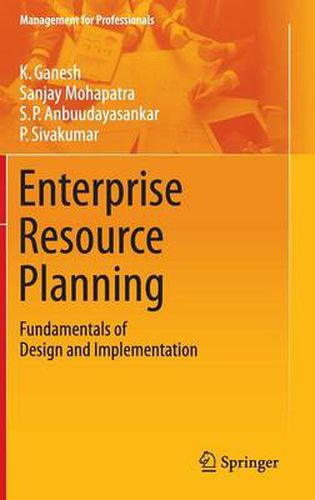Readings Newsletter
Become a Readings Member to make your shopping experience even easier.
Sign in or sign up for free!
You’re not far away from qualifying for FREE standard shipping within Australia
You’ve qualified for FREE standard shipping within Australia
The cart is loading…






This title is printed to order. This book may have been self-published. If so, we cannot guarantee the quality of the content. In the main most books will have gone through the editing process however some may not. We therefore suggest that you be aware of this before ordering this book. If in doubt check either the author or publisher’s details as we are unable to accept any returns unless they are faulty. Please contact us if you have any questions.
This book introduces the fundamental principles of understanding business requirements to apply enterprise resource planning (ERP) in order to meet business needs. The book also helps readers understand the usage of ERP for monitoring and controlling business processes, while providing practical oriented solutions to the design and implementation of ERP. Using the provided framework, a business can decide to provide more value at lower cost which increases its competitive advantage. This should be an ideal reference for executives, researchers and consultants in project management of ERP.
ERP can be considered to be an integrated package of business process. The scope of ERP determines the extent of automation of business process. For example if ERP covers Human Resource (HR) and finance business processes only, then business process related HR and finance are automated. Typically business process that are automated in HR and finance employee entry and exist process, allocation of employee ID, payroll, processing , income tax planning and actual deduction etc. There is seamless flow of employee data and information is available at an effectively faster rate to take appropriate decision.
As custom demand increases, there is a need to meet the changing scenario with speed and efficiency. While there is a need to increase productivity, there is also a need to reduce cost of operation. The repetitive business processes can be handled effectively by automating them and freeing human resources for meeting other uncertainties. These automations not only should be done for each department, but also should cut across different departments. Thus there is a need for automating business processes at enterprise level. This enterprise level automation started with MRP, then MRP II, ERP and then finally open source ERP have taken centre stage. Out of the standard products available in the market, an organization can chose an ERP product for implementation, depending on the features available and the total cost of ownership (TCO). This comparison helps an organization to choose the product that best suits the needs for the organization. Enterprise Resource Planning: Fundamentals of Design and Implementation highlights these concepts while discusses different good practices to design and implement ERP.
$9.00 standard shipping within Australia
FREE standard shipping within Australia for orders over $100.00
Express & International shipping calculated at checkout
This title is printed to order. This book may have been self-published. If so, we cannot guarantee the quality of the content. In the main most books will have gone through the editing process however some may not. We therefore suggest that you be aware of this before ordering this book. If in doubt check either the author or publisher’s details as we are unable to accept any returns unless they are faulty. Please contact us if you have any questions.
This book introduces the fundamental principles of understanding business requirements to apply enterprise resource planning (ERP) in order to meet business needs. The book also helps readers understand the usage of ERP for monitoring and controlling business processes, while providing practical oriented solutions to the design and implementation of ERP. Using the provided framework, a business can decide to provide more value at lower cost which increases its competitive advantage. This should be an ideal reference for executives, researchers and consultants in project management of ERP.
ERP can be considered to be an integrated package of business process. The scope of ERP determines the extent of automation of business process. For example if ERP covers Human Resource (HR) and finance business processes only, then business process related HR and finance are automated. Typically business process that are automated in HR and finance employee entry and exist process, allocation of employee ID, payroll, processing , income tax planning and actual deduction etc. There is seamless flow of employee data and information is available at an effectively faster rate to take appropriate decision.
As custom demand increases, there is a need to meet the changing scenario with speed and efficiency. While there is a need to increase productivity, there is also a need to reduce cost of operation. The repetitive business processes can be handled effectively by automating them and freeing human resources for meeting other uncertainties. These automations not only should be done for each department, but also should cut across different departments. Thus there is a need for automating business processes at enterprise level. This enterprise level automation started with MRP, then MRP II, ERP and then finally open source ERP have taken centre stage. Out of the standard products available in the market, an organization can chose an ERP product for implementation, depending on the features available and the total cost of ownership (TCO). This comparison helps an organization to choose the product that best suits the needs for the organization. Enterprise Resource Planning: Fundamentals of Design and Implementation highlights these concepts while discusses different good practices to design and implement ERP.